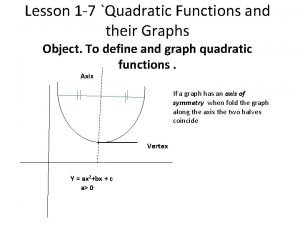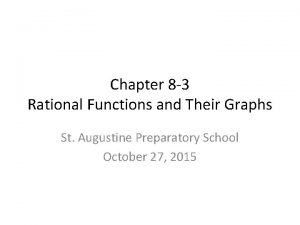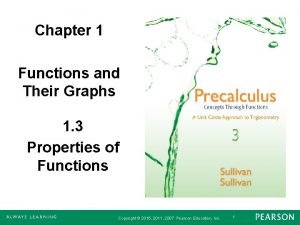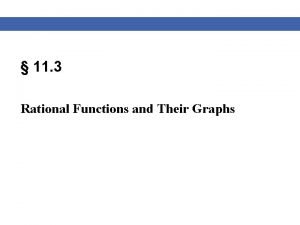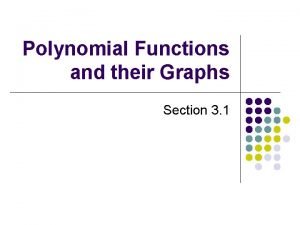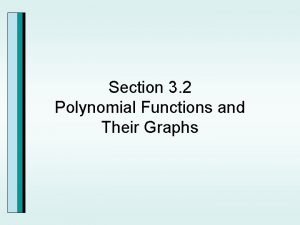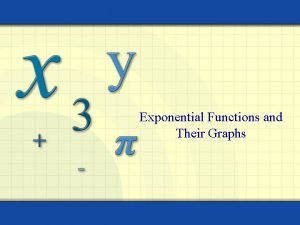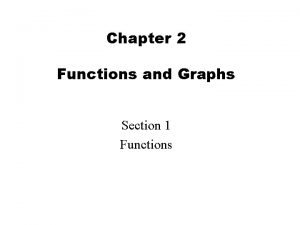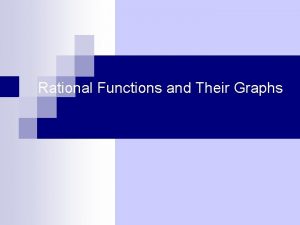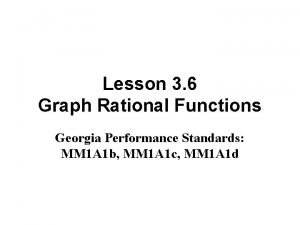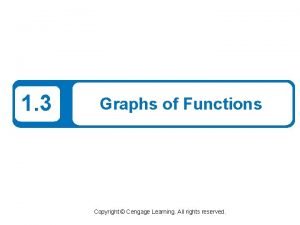1 Functions and Their Graphs Copyright Cengage Learning































- Slides: 31

1 Functions and Their Graphs Copyright © Cengage Learning. All rights reserved.

1. 3 Graphs of Functions Copyright © Cengage Learning. All rights reserved.

What You Should Learn • Find the domains and ranges of functions and use the Vertical Line Test for functions • Determine intervals on which functions are increasing, decreasing, or constant • Determine relative maximum and relative minimum values of functions • • Identify and graph piecewise-defined functions Identify even and odd functions 3

The Graph of a Function 4

The Graph of a Function The graph of a function f is the collection of ordered pairs (x, f (x)) such that x is in the domain of f. As you study this section, remember the geometric interpretations of x and f (x). x = the horizontal distance from the y-axis f (x) = the vertical distance from the x-axis 5

Example 1 – Finding the Domain and Range of a Function Use the graph of the function f shown below to find: (a) the domain of f, (b) the function values f (– 1) and f (2), and (c) the range of f. Figure 1. 18 6

Example 1 – Solution a. The closed dot at (– 1, – 5) indicates that x = – 1 is in the domain of f, whereas the open dot at (4, 0) indicates that x = 4 is not in the domain. So, the domain of f is all x in the interval [– 1, 4). Therefore, Domain = [-1, 4) which includes -1, but not 4. b. Because (– 1, – 5) is a point on the graph of f, it follows that f (– 1) = – 5. 7

Example 1 – Solution cont’d Similarly, because (2, 4) is a point on the graph of f, it follows that f (2) = 4. c. Because the graph does not extend below f (– 1) = – 5 or above f (2) = 4, the range of is the interval [– 5, 4]. Therefore, Range = [-5, 4] which includes -5 and 4. 8

The Graph of a Function By the definition of a function, each x value may only correspond to one y value. It follows, then, that a vertical line can intersect the graph of a function at most once. This leads to the Vertical Line Test for functions. 9

Example 3 – Vertical Line Test for Functions Use the Vertical Line Test to decide whether the graphs in Figure 1. 19 represent y as a function of x. (a) (b) Figure 1. 19 10

Example 3 – Solution a. This is not a graph of y as a function of x because you can find a vertical line that intersects the graph twice. b. This is a graph of y as a function of x because every vertical line intersects the graph at most once. 11

Increasing and Decreasing Functions 12

Increasing and Decreasing Functions Consider the graph shown below. Moving from left to right, this graph falls from x = – 2 to x = 0, is constant from x = 0 to x = 2, and rises from x = 2 to x = 4. Figure 1. 20 13

Increasing and Decreasing Functions 14

Example 4 – Increasing and Decreasing Functions In Figure 1. 21, determine the open intervals on which each function is increasing, decreasing, or constant. (a) (b) (c) Figure 1. 21 15

Example 4 – Solution a. Although it might appear that there is an interval in which this function is constant, you can see that if x 1 < x 2, then (x 1)3 < (x 2)3, which implies that f (x 1) < f (x 2). This means that the cube of a larger number is bigger than the cube of a smaller number. So, the function is increasing over the entire real line. b. This function is increasing on the interval ( , – 1), decreasing on the interval (– 1, 1), and increasing on the interval (1, ). 16

Example 4 – Solution cont’d b. This function is increasing on the interval ( , – 1), decreasing on the interval (– 1, 1), and increasing on the interval (1, ). c. This function is increasing on the interval ( , 0), constant on the interval (0, 2), and decreasing on the interval (2, ). 17

Relative Minimum and Maximum Values 18

Relative Minimum and Maximum Values The points at which a function changes its increasing, decreasing, or constant behavior are helpful in determining the relative maximum or relative minimum values of the function. 19

Relative Minimum and Maximum Values Figure 1. 22 shows several different examples of relative minima and relative maxima. Figure 1. 22 20

Piecewise-Defined Functions 21

Example 8 – Sketching a Piecewise-Defined Function Sketch the graph of f (x) = 2 x + 3, x ≤ 1 –x + 4, x > 1 by hand. 22

Example 8 – Solution: This piecewise-defined function is composed of two linear functions. At and to the left of x = 1, the graph is the line given by y = 2 x + 3. To the right of x = 1, the graph is the line given by y = –x + 4 23

Example 8 – Solution cont’d The two linear functions are combined and below. Notice that the point (1, 5) is a solid dot and the point (1, 3) is an open dot. This is because f (1) = 5. Figure 1. 29 24

Even and Odd Functions 25

Even and Odd Functions A graph has symmetry with respect to the y-axis if whenever (x, y) is on the graph, then so is the point (–x, y). A graph has symmetry with respect to the origin if whenever (x, y) is on the graph, then so is the point (–x, –y). A graph has symmetry with respect to the x-axis if whenever (x, y) is on the graph, then so is the point (x, –y). A function whose graph is symmetric with respect to the y -axis is an even function. A function whose graph is symmetric with respect to the origin is an odd function. 26

Even and Odd Functions A graph that is symmetric with respect to the x-axis is not the graph of a function (except for the graph of y = 0). These three types of symmetry are illustrated in Figure 1. 30. Symmetric to y-axis Even function Symmetric to origin Odd function Figure 1. 30 Symmetric to x-axis Not a function 27

Even and Odd Functions 28

Example 10 – Even and Odd Functions Determine whether each function is even, odd, or neither. a. g(x) = x 3 – x b. h(x) = x 2 + 1 c. f (x) = x 3 – 1 Solution: a. This function is odd because g (–x) = (–x)3+ (–x) = –x 3 + x = –(x 3 – x) = –g(x). 29

Example 10 – Solution b. This function is even because h (–x) = (–x)2 + 1 = x 2 + 1 = h (x). c. Substituting –x for x produces f (–x) = (–x)3 – 1 = –x 3 – 1. 30

Example 10 – Solution cont’d Because f (x) = x 3 – 1 and –f (x) = –x 3 + 1 you can conclude that f (–x) f (x) and f (–x) –f (x). So, the function is neither even nor odd. 31
 Copyright cengage learning. powered by cognero
Copyright cengage learning. powered by cognero Which two graphs are graphs of polynomial functions?
Which two graphs are graphs of polynomial functions? Horizontal asymptote rules
Horizontal asymptote rules Quadratic functions and their graphs
Quadratic functions and their graphs Vertical answer
Vertical answer Chapter 1 functions and their graphs
Chapter 1 functions and their graphs Sketch the graph of the following rational function
Sketch the graph of the following rational function Common functions and their graphs
Common functions and their graphs Types of polynomials based on degree
Types of polynomials based on degree Polynomial functions and their graphs
Polynomial functions and their graphs Analyzing graphs of polynomial functions calculator
Analyzing graphs of polynomial functions calculator Exponential functions and their graphs
Exponential functions and their graphs Chapter 2 functions and their graphs answers
Chapter 2 functions and their graphs answers Horizontal asymptote
Horizontal asymptote Lesson 3 rational functions and their graphs
Lesson 3 rational functions and their graphs Investigating graphs of polynomial functions
Investigating graphs of polynomial functions Investigating graphs of polynomial functions
Investigating graphs of polynomial functions Good state graphs and bad state graphs in software testing
Good state graphs and bad state graphs in software testing Graphs that enlighten and graphs that deceive
Graphs that enlighten and graphs that deceive Chapter 6:2 interpreting word parts
Chapter 6:2 interpreting word parts Chapter 5 learning exercises medical terminology
Chapter 5 learning exercises medical terminology Cengage learning heart diagram
Cengage learning heart diagram South-western cengage learning
South-western cengage learning Chapter 13 medical math assignment sheet
Chapter 13 medical math assignment sheet 2009 delmar cengage learning
2009 delmar cengage learning Cengage learning heart diagram
Cengage learning heart diagram Introduction to medical terminology chapter 1 answer key
Introduction to medical terminology chapter 1 answer key Cengage learning australia
Cengage learning australia 2009 delmar cengage learning
2009 delmar cengage learning Cengage learning
Cengage learning Cengage learning
Cengage learning Wadsworth cengage learning
Wadsworth cengage learning



